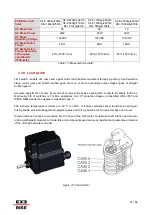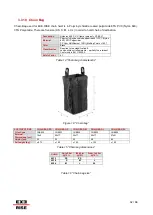
17 / 66
Do not lift the load above people or do not leave hanging loads without the operator’s control and
appropriate measures.
Do not use the hoist outdoors or anywhere with water jets or environmental conditions without adequate
protection.
The use in explosive, aggressive atmosphere or with high concentration of powders or oily substances
suspended in the air is prohibited. Electrical devices produce arcs or sparks that can cause a fire or
explosion.
Do not operate hoist at unusual extremes of ambient temperatures. The product is designed for use in
temperatures ranging between -10°C and +40°C.
It is prohibited to tamper with the hoist in order to modify its performances.
Do not remove or tamper with the protective and safety devices
Use of the hoist is prohibited to unauthorised operators who are not adequately trained in use of the
hoist and the associated dangers.
Do not use of the hoist outside the limits indicated in this document.
Make sure the chain is running straight into the hoist body. Any side pull will cause significant wear
and tear on the hoist.
Do not apply a lateral load to the body of the hoist.
Make sure the pick-up points are always in-line with the hoist. Any side pull will cause an increase in
loading on both the hoist and the structure.
2.5
SAFETY WARNING FOR RESIDUAL RISKS
Residual risks related to a machine are accident risks that remain after the carrying out of all the safety
measures taken by the manufacturer (and which therefore must be managed by the user).
The most serious residual risks are indicated on the hoists safety labels. These are as listed below (
Table 1
).
Residual risk, dangerous zone
and person exposed
Course of action to eliminate or reduce risk
Malfunction or falling load due to
overload
Do not exceed the hoist load limit
Various types of risks owing to the
wrong installation and use of the
hoist.
Read the instructions before installing or using the hoist
Fall risk to people being lifted by
the hoist
It is prohibited to lift people by means of the hoist
Damage to hoist due to dry chain
Chain should be kept lubricated
Risks of structural collapse
Check structure is able to support the proposed load. Check all
components in the lifting system are suitably rated and able to bear
the proposed load
Risk of injury from malfunction hoist
or manoeuvre error
Working area should be managed and access controlled
Fall risks (of the installer or
serviceman) from the load or
structure
Appropriate PPE should always be used. Climbing the load or
structures should be avoided if possible. When possible carry out all
maintenance at ground level
Various types of risks owing to the
illegibility of the labels
Do not remove or cover labels
Various types of risks owing to the
lack in periodical maintenance
Check that the annual periodical maintenance has been carried out.
Various types of risks when used in
severe weather conditions
Check the environment conditions before using the hoist.





































